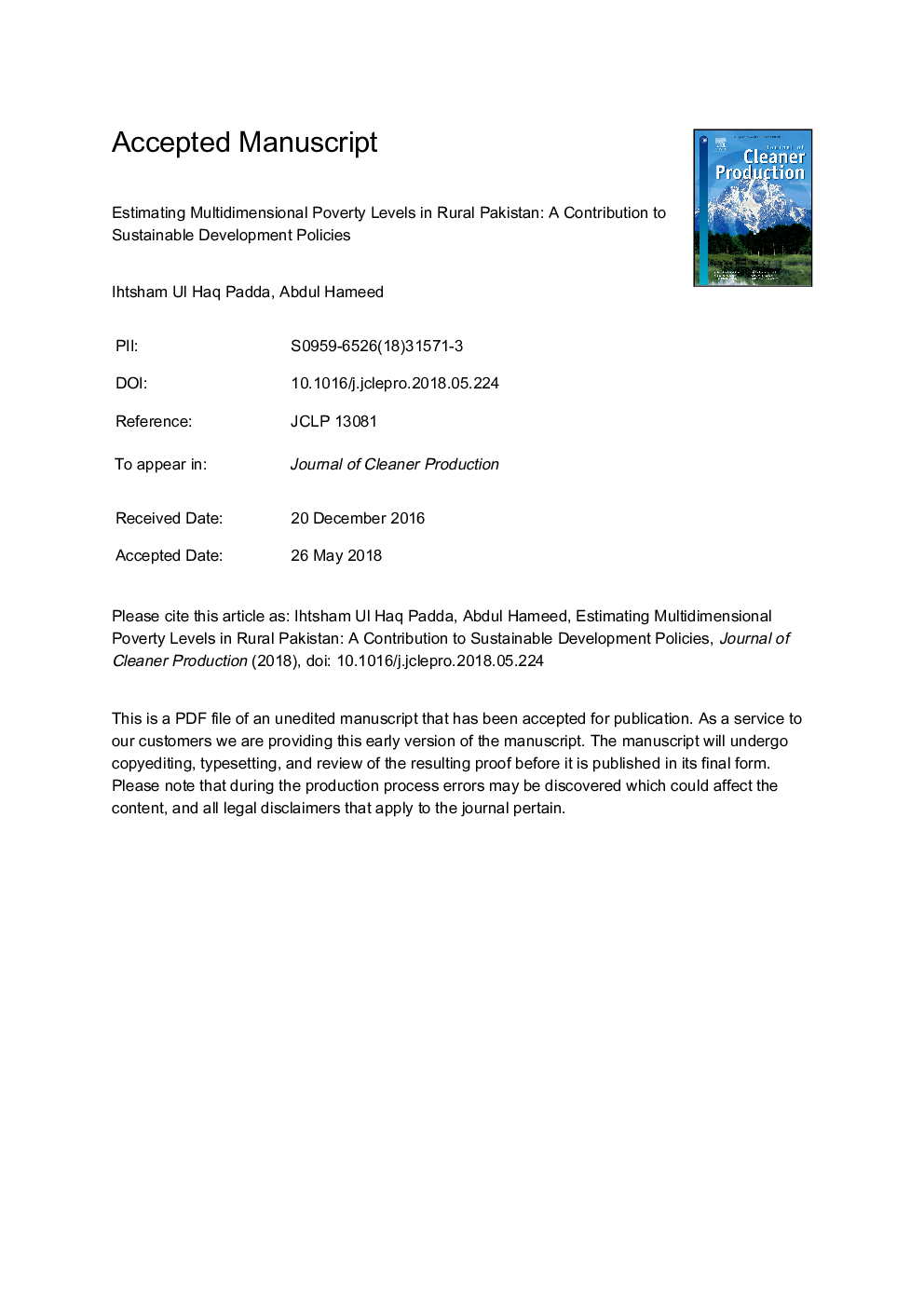| کد مقاله | کد نشریه | سال انتشار | مقاله انگلیسی | نسخه تمام متن |
|---|---|---|---|---|
| 8093895 | 1522056 | 2018 | 19 صفحه PDF | دانلود رایگان |
عنوان انگلیسی مقاله ISI
Estimating multidimensional poverty levels in rural Pakistan: A contribution to sustainable development policies
ترجمه فارسی عنوان
برآورد سطح فقر چند بعدی در پاکستان روستایی: کمک به سیاست های توسعه پایدار
دانلود مقاله + سفارش ترجمه
دانلود مقاله ISI انگلیسی
رایگان برای ایرانیان
کلمات کلیدی
فقر روستایی، توسعه پایدار، نمرات اجتماعی و اقتصادی، تجزیه و تحلیل مولفه اصلی،
ترجمه چکیده
کاهش فقر مهمترین هدف اهداف توسعه پایدار است. توسعه پایدار یک مشکل اساسی برای مناطق روستایی پاکستان است که عمدتا با استانداردهای زندگی، کشاورزی و دارایی های غیر کشاورزی و شاخص های محیط زیست مرتبط است. این مطالعه با هدف ارزیابی محرومیت چند بعدی و سطح فقر برای پاکستان روستایی با استفاده از داده های تحقیق در بخش روستایی پاکستان در سال 2013 و استفاده از تجزیه و تحلیل مولفه های اصلی انجام شده است. ابعاد محرومیت با بررسی عوامل ذیل مورد بررسی قرار گرفته است: دارایی های کشاورزی و غیر کشاورزی، مسکن، آموزش، انرژی، بهداشت، و دسترسی به آب آشامیدنی تمیز. این مطالعه نشان می دهد که 44 درصد از خانوارهای پاکستانی روستایی در فقیرترین و فقیرترین مناطق زندگی می کنند، فقدان آب آشامیدنی خالص، امکانات بهداشتی ناکافی، شرایط مسکن ضعیف، منابع انرژی آلوده و فقدان منابع اقتصادی است. تجزیه و تحلیل سطح منطقه نشان می دهد که جمعیت روستایی حیدرآباد، تتا و سانگر فقیرترین مناطق است. بنابراین، برای دستیابی به توسعه پایدار و کاهش فقر، بودجه های اضافی از دولت های فدرال، والیتی و محلی برای رفاه اجتماعی، آموزش و پرورش، بهداشت، آب، و توسعه کشاورزی در مناطق روستایی پاکستان اختصاص می یابد. این مطالعه نیاز به یک روش سیاست چند بعدی ای دارد که هدف آن کاهش فقر و توسعه پایدار در سطح منطقه است.
موضوعات مرتبط
مهندسی و علوم پایه
مهندسی انرژی
انرژی های تجدید پذیر، توسعه پایدار و محیط زیست
چکیده انگلیسی
Poverty reduction is the foremost, imperative objective of sustainable development goals. Sustainable development is a crucial problem for the rural areas of Pakistan mainly associated with living standards, agriculture and nonagriculture assets, and environment indicators. This study aims to estimate multidimensional deprivation and poverty levels for rural Pakistan using data from the 2013 Pakistan Rural Household Survey (PRHS) and applying principal component analysis. The dimensions of deprivation have been identified by examining the following factors: agricultural and nonagricultural assets, housing, education, energy, sanitation, and access to clean drinking water. This study finds that 44% of households in rural Pakistan are living at the poorest and poor levels, enduring a lack of pure drinking water, inadequate sanitation facilities, poor housing conditions, polluted energy sources, and privation of economic resources. The district level analysis demonstrates that the rural populations of Hyderabad, Thatta, and Sangher are the poorest. Thus, to attain sustainable development and poverty reduction, additional funds from the federal, provincial, and local governments should be allocated for social welfare, education, sanitation, water supply, and agriculture development in rural areas of Pakistan. This study calls for a multidimensional policy approach targeting poverty reduction and sustainable development at the district level.
ناشر
Database: Elsevier - ScienceDirect (ساینس دایرکت)
Journal: Journal of Cleaner Production - Volume 197, Part 1, 1 October 2018, Pages 435-442
Journal: Journal of Cleaner Production - Volume 197, Part 1, 1 October 2018, Pages 435-442
نویسندگان
Ihtsham Ul Haq Padda, Abdul Hameed,
